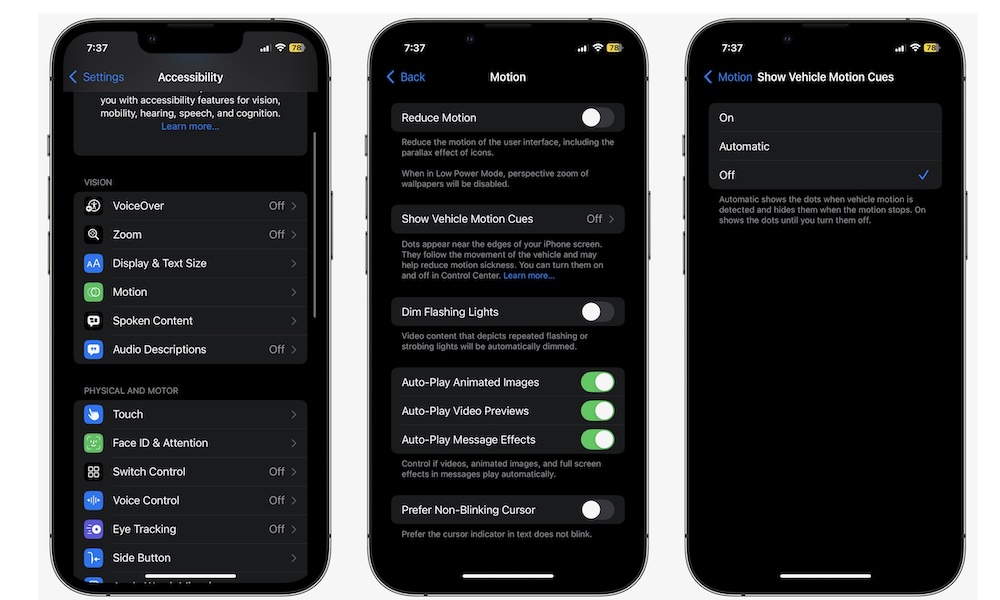With every new software update, Apple adds many different features that you probably don’t know exist until the next update. However, Apple does add some amazing software features that you should probably know about in case you need them.
iOS 18 is a perfect example of that. Not only did the new software update bring a bunch of amazing features to the table, but it also includes new accessibility features that are a game changer for many of us.
Why, I hear you ask? Well, that’s because Apple found a clever way to deal with motion sickness when you’re in a car. Yes, it sounds like a gimmick and too good to be true, but it works — and it’s more useful than you might think. It’s already helped a lot of users around the world.
Motion sickness is extremely common. According to Medline Plus, one in three people are highly susceptible to motion sickness. Not only that, but according to Seattle Children’s Hospital, up to 25% might experience symptoms of motion sickness as a passenger in a moving car.
Needless to say, this feature can improve your life in many ways.
If you suffer from motion sickness, or you know someone who does, here’s what you need to know about Apple’s new Vehicle Motion Cues and how it can help you reduce your motion sickness.
What Is the New “Vehicle Motion Cues” Feature?
With iOS 18 and iPadOS 18, Apple introduced a new accessibility feature called Vehicle Motion Cues. This feature, as explained by Apple itself, uses animated dots on the edges of the screen that automatically move when your iPhone detects you’re in a moving vehicle.
Motion sickness in a moving vehicle doesn’t just happen because you’re looking at your phone; it can happen when you’re fixing your sight on any object. That’s because you’re looking at something inside the car your brain makes you believe you’re standing still. However, your body is still moving because of the car’s motion, which triggers a response in your brain that makes you feel dizzy or sick.
But how can your iPhone fix that? Well, the new Vehicle Motion Cues feature uses sensors built into your iPhone or iPad to know when you’re moving inside a vehicle. This will trigger the dots on the edges of your screen to move based on the movements of your car.
Your eyes will see this movement, letting your brain know you’re actually moving so your body and brain won’t have any conflict. Your brain and body will both know you’re in motion, which will reduce motion sickness.
Yes, it might sound too good to be true, especially if you’ve tried other things before, but nothing seems to work. However, many users have reported that this feature has been helpful, so it can’t hurt to set it up and try it yourself.
How to Set Up iOS 18’s Vehicle Motion Cues Feature
If you want to try fixing your motion sickness with iOS 18, setting up the Vehicle Motion Cues feature couldn’t be any easier. It will only take you a few seconds, and here’s what you need to do:
- Open the Settings app.
- Scroll down and go to Accessibility.
- Tap on Motion.
- Go to Show Vehicle Motion Cues.
- Tap on On.
You can also select Automatic, which automatically turns this feature on or off whenever your iPhone “feels” you’re in a moving vehicle. However, in our experience, this feature doesn’t work as well as you might expect, especially if you have an older iPhone.
For instance, sometimes, our iPhone didn’t know it was inside a moving vehicle. We also experienced times when the iPhone would automatically turn the feature on if we pulled it out of our pocket too quickly.
So, instead of using the Automatic option, we recommend you add the Vehicle Motion Cues feature to your Control Center.
After you turn it on, your iPhone should add it for you, but if it doesn’t, you can do it yourself by opening the Control Center and then pressing and holding an empty space until the screen changes. Next, tap on Add a Control, scroll down to the bottom, and under Vision Accessibility, tap on Vehicle Motion Cues. That way, you can turn it on and off whenever you want.
Does iOS 18’s Motion Sickness Feature Actually Work?
Like many other accessibility features in your iPhone, the new Vehicle Motion Cues feature might not work the same for everyone. Some people might find it helpful, while others won’t notice any difference.
That said, we’ve found it surprisingly helpful, and many folks around the web have expressed how great this new motion sickness feature has been.
As we mentioned, the animated dots around the edges of your iPhone will help you make your brain and body feel like they’re moving with the vehicle, so this feature should help many people.
However, we recommend you try it out for yourself and see if it works as well for you as it has for many of us.
Get Rid of Motion Sickness Once and For All
As you probably know, not every iPhone feature Apple brags about works as the company intends. Some accessibility features can be hit or miss for many users, as Apple can’t cover all scenarios with a single feature — or at least, not yet.
That said, the new Vehicle Motion Cues feature has been incredibly useful for most iPhone users. It’s a simple but effective feature that will be a game changer for many of us, especially for those of us who sometimes have to work while we’re in a moving vehicle.
If that’s your situation, we recommend trying the new Vehicle Motion Cues feature. Play with it and see if it works for you.
